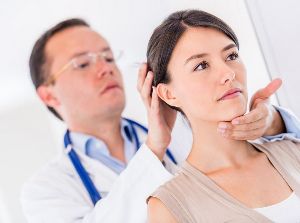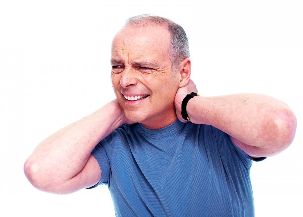Like other diseases of the spine, grade 1 cervical osteochondrosis is characterized by pain. The nature of the pain can be called tolerable, but this gives no reason to leave the disease without seeking medical attention and further treatment. Ignoring the symptoms of osteochondrosis, which is still in stage 1, can lead to deterioration of the patient's condition and further development of the disease.
Self-treatment is not recommended, only an experienced doctor can make the correct diagnosis, determine the cause of the symptoms of the disease and give clear recommendations for the treatment of osteochondrosis.Causes of the disease
Against the background of grade 1 osteochondrosis of the cervical spine, first of all, there is pain of a shooting nature, called lumbago. The pain syndrome occurs in the cervical region, in severe cases it spreads to the area of the shoulders, arms and chest muscles. This is because the intervertebral discs tend to be damaged to a greater extent when the mobile part of the spine (cervical region) is connected to the less mobile, thoracic region.

The cervical region consists of 7 vertebrae. The first two support the skull, so a person can rotate the head, tilt and raise it. The vertebrae are connected by movable joints and ligaments, and the intervertebral discs, made up of cartilage tissue, serve as a divider between the vertebrae. The adjacent muscles are also designed to hold the spine in a vertical position, if the muscle corset is well developed, the back will be stable. As you can see, well-coordinated work of the vertebrae, intervertebral discs and muscles ensures the healthy functioning of the spine. As soon as a connection from this system starts to malfunction, disturbances occur throughout the work of the spine.
For what reasons may there be violations and the first symptoms of osteochondrosis appear:
- sedentary lifestyle;
- excessive physical activity;
- wrong sleeping position;
- food that does not provide the body with a sufficient amount of substances that strengthen bones and muscular systems;
- bad habits;
- stress;
- lack of adequate rest, fatigue;
- hypothermia and frequent colds.
If the muscles that support the spine in a stable position begin to age and lose tone by nearly 50 years - this may be considered normal. But when the cervical vertebrae undergo a deformation process at the age of 20, it is worth paying attention and taking action. Undergo a preventative treatment, exercise, be active and avoid sitting work with your neck and back bent.
Symptoms
To list the main signs and symptoms that can accurately determine grade 1 cervical osteochondrosis, it is necessary to clarify the concept itself.
Grade 1 osteochondrosis is the initial stage of the disease, characterized so far only by the compression of the cartilaginous tissue of the discs between the vertebrae. The spine is still in a stable position, but the processes of the cervical vertebrae are already increasing in size. Disk displacement is at a minimum, but its outer cortex, composed of fibrous tissue, begins to detach, which, if left untreated, can lead to the development of later stages of osteochondrosis and even an intervertebral hernia. .Main symptoms of cervical spine osteochondrosis:
- pain syndrome begins in the neck region, spreading to the shoulder joints, shoulder blade, and chest muscles;
- squeezing the nerve endings leads to the appearance of a shooting pain in the neck, especially this condition is exacerbated by an unpleasant sleeping behavior, at night, the patient after waking up keeps the neck in an unnatural position for a long time due toof the inability to return without a headache;
- against the background of nerve root compression, cardiac syndrome can occur - chest muscle soreness, which a person confuses with heart pain (examination does not confirm the presence of cardiac pathologies);
- due to vertebral artery syndrome, blood supply to the brain and spinal cord deteriorates, which provokes headaches, visual disturbances in the form of "flies in front of the eyes", dizziness, pain in the occipital region;
- sleep disorders;
- I'm worried.

Pain syndrome is accompanied by muscle spasms in the affected back area. Grade 1 spinal osteochondrosis may not predict the pronounced symptoms listed, it all depends on the body’s sensitivity to pain and the overall well-being of the patient.
With constant fatigue, sedentary work and stress, any of the symptoms of the disease are perceived more acutely. Therefore, the first sign of osteochondrosis - shooting pain in the neck, especially after physical exertion or hypothermia - should be the reason for a visit to the doctor.
Treatment and prevention
Therapy of class 1 cervical osteochondrosis should, first of all, aim at the elimination of the pain syndrome and the initiation of active metabolic processes in the tissues of the intervertebral discs. Also, it is necessary to strengthen the muscular frame of the neck to keep the spine in a strong and stable position.
Drug therapy includes the following methods:
- pain relievers, anti-inflammatory drugs;
- physiotherapy;
- massage;
- acupuncture;
- medical gymnastics;
- not.
With the help of drug therapy, it is necessary to relieve pain and inflammation in the affected area, in this case, the doctor may combine the appointment of oral anesthetic drugs with injections of vitamins, anti-inflammatory drugs. A good effect is given by the application of external agents in the form of warming gels based on pain relievers, as well as bee and snake venom.
An adjunct to medication therapy and physiotherapy can be therapeutic exercises, which will help to gently stretch the spine, freeing the compressed nerve roots and relieving neck pain. Subsequent preventive measures are a healthy, active lifestyle, sports, good nutrition, as well as avoiding stress and hypothermia.























